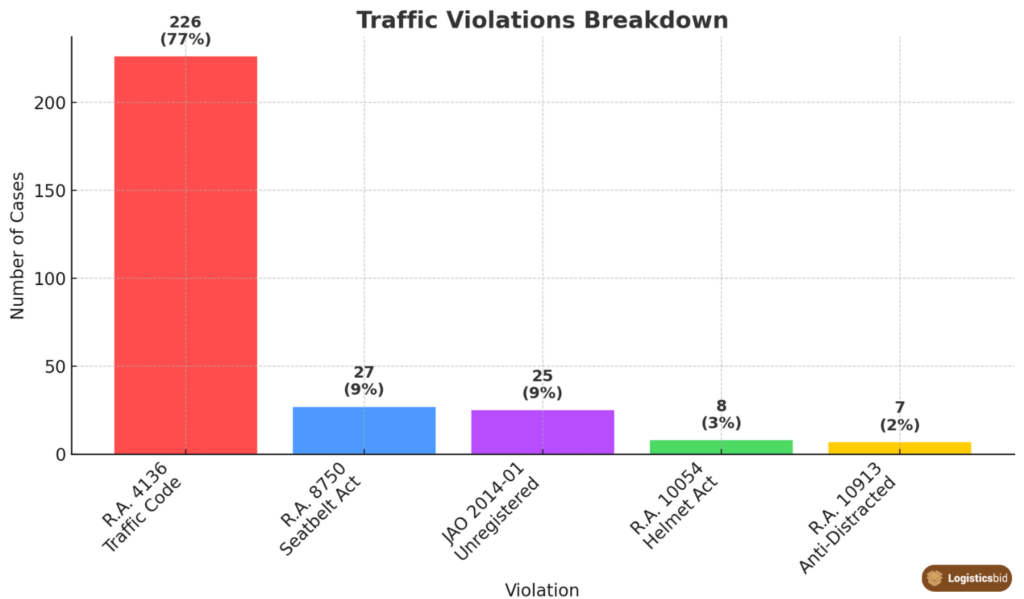
The Holy Week break is one of the busiest travel periods in the Philippines, with millions of people hitting the roads to visit family and friends. However, navigating through heavy traffic can be stressful and overwhelming. To make your journey more enjoyable and hassle-free, here are some safe driving tips to consider.

Every year, the Holy Week period brings an influx of travelers who hit the road, resulting in congested roads and increased travel times. According to the Land Transportation Office (LTO) recent report on March 3, 2025, there were 296 traffic violations. The most common violation was R.A. 4136 (Land Transportation and Traffic Code) with 226 cases, followed by R.A. 8750 (Seatbelt Use Act of 1999) with 27 cases, and JAO 2014-01, Section 2A (Unregistered Motor Vehicle) with 25 cases. Other violations included R.A. 10054 (Motorcycle Helmet Act of 2009) with 8 cases and R.A. 10913 (Anti-Distracted Driving Act) with 7 cases. The LTO reiterated the importance of using seatbelts in four-wheeled vehicles and helmets for two-wheeled vehicles as crucial safety measures.
Safe Driving Tips: Ensuring Vehicle Readiness

1. Comprehensive Vehicle Check-Up
To prevent breakdowns, it’s imperative to have a full car service that includes an oil change and inspection of the vehicle’s fluids. This maintenance helps prevent overheating and mechanical failures, particularly during long drives. Routine maintenance can extend the life of a vehicle by about 50%.
2. Tire Inspection and Alignment
Tires are a critical component; therefore, check for wear and ensure they’re properly aligned. Rotate or replace tires as needed, and verify the spare tire’s condition. The Land Transportation Office (LTO) states that proper tire pressure can improve gas mileage by about 3.3%.
- Tire Pressure: Check tire pressure regularly to avoid blowouts or uneven wear.
- Fluid Levels: Check oil, coolant, and brake fluid levels to prevent overheating or mechanical failure.
- Battery Maintenance: Ensure the battery is in good condition by checking the water level, terminal cleanliness, and charging system.
Hit the Road with Strategic Travel Plans
Optimizing Packing
Traveling light increases fuel efficiency. Overloading the car strains the engine and can affect tire pressure and handling.
Tip: According to Consumer Reports, a 100-pound reduction in weight improves fuel economy by about 1%.
Considerate Timing of Travel
To avoid vehicle strain and personal discomfort, plan your travels during cooler parts of the day, typically before 11:30 a.m. or after 3 p.m.
Actual Safe Driving Tips and Practices
-
Consistent Speed Maintenance
Maintain a steady speed around 100 kph to optimize fuel consumption and reduce stress on the vehicle. This approach can also decrease driver fatigue. Department of Energy reports that consistent speeds can improve fuel efficiency by up to 12%.
-
Positive Overtaking
When overtaking, ensure you’re doing so with confidence, using adequate throttle to minimize time spent in the opposite lane, especially on two-lane roads.
-
Road Etiquette and Mindfulness in Intersections and Mountain Roads
Quote by Traffic Safety Expert: “The courtesy of yielding is not only a sign of respect but also a significant factor in preventing accidents.” Approach intersections cautiously, always being ready to yield if necessary. In mountain regions, give way to vehicles moving uphill.
-
Calm Amidst Traffic
Engage in calming activities such as prayer or deep breathing exercises when stuck in traffic. This can reduce stress and improve focus when driving resumes.
Other Safe Driving Tips While On The Road
-
Stay Alert
Stay alert and hit the road mind-focused, avoiding distractions like using your phone or eating while driving.
-
Follow Speed Limits
Follow speed limits and adjust your speed according to road conditions to avoid accidents.
-
Use Headlights
Use headlights at night or in low-visibility conditions to increase visibility and safety.
-
Avoid Aggressive Driving
Avoid aggressive driving, such as tailgating or weaving in and out of lanes.
Hit the Road with Safety Precautions>
-
Emergency Kit
Keep an emergency kit in your car, including items like a first-aid kit, jumper cables, and snacks.
-
First-Aid Training
Consider taking a first-aid training course to learn basic life-saving techniques.
-
Car Insurance
Ensure you have adequate car insurance coverage to protect yourself and your loved ones in case of an accident.
By following these driving tips, you can help ensure a safe and enjoyable journey during the Holy Week period. Remember to always prioritize your safety and the safety of others on the road.
Supporting Services During Holy Week>
Besides your preparations, consider leveraging delivery and transportation services that remain operational even during Holy Week. Platforms like Transportify, Lalamove, and other logistics companies provide logistics services that help deliver essential goods, ensuring that your trips are as seamless as possible.
By meticulously preparing your vehicle and adopting a strategic approach to travel, you can ensure a safer journey during the busy Holy Week period. Remember, safety is paramount—adhering to best practices not only protects you but also ensures the welfare of your fellow travelers. Prioritize vehicle checks, travel smartly, drive safely, and use available delivery services if necessary.
SEE ALSO:
